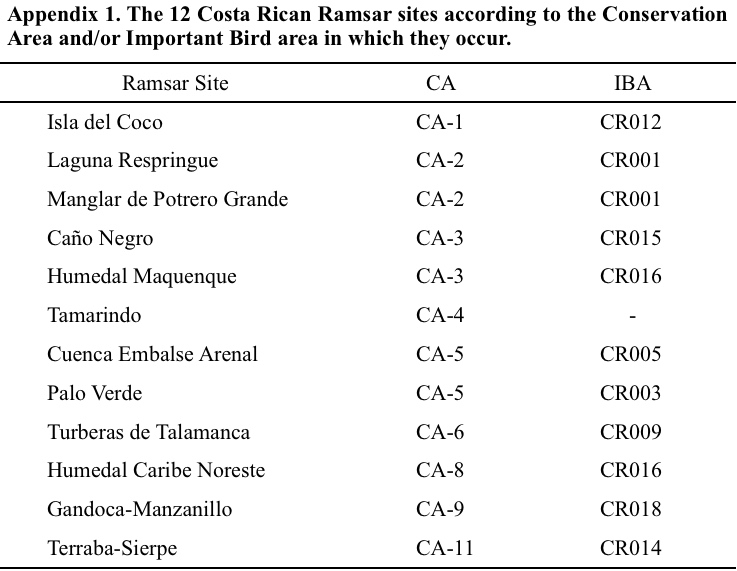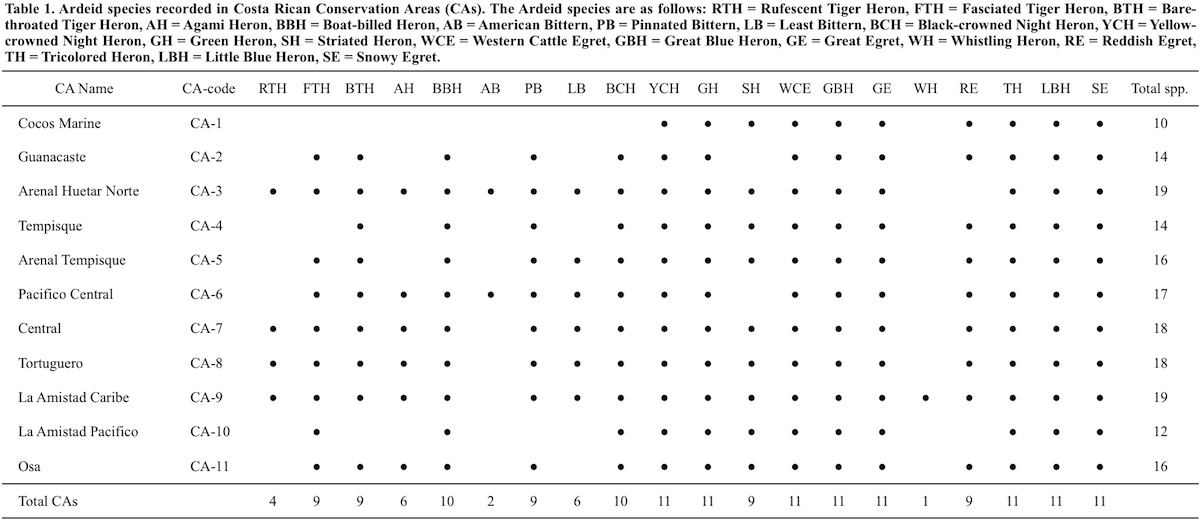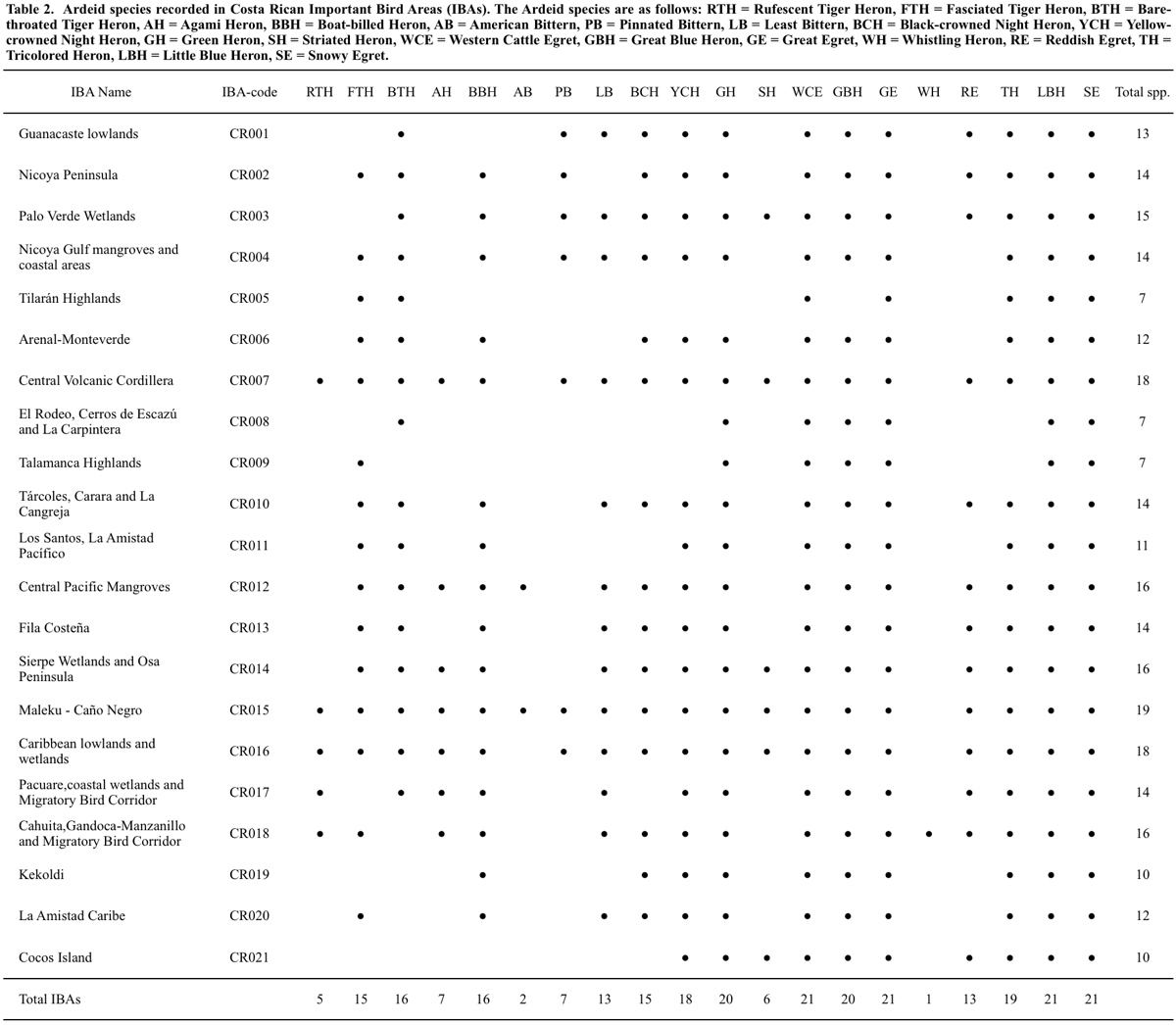Importance of Conservation Areas and Important Bird Areas for Ardeid conservation and management in Costa Rica #
Abstract
Costa Rica has 350 documented wetlands comprising 350,000 ha in the National Wetland Inventory, all of which are included in the country’s 11 Conservation (Administrative) Areas (CAs) of the Environmental Ministry; many of them are also included in the country’s 21 Important Bird Areas (IBAs). Twelve of these wetlands have been designated as a “Key Wetland” and have specific and more exhaustive studies; the other 338 wetlands have received little study and their diversity is poorly known. Ardeid species live and move throughout the country. The objective of this paper is to identify and rank the CAs, IBAs and the Ramsar sites for Ardeid diversity, thereby increasing and enriching knowledge about the importance of the Costa Rican CAs, IBAs and wetlands for future Ardeid conservation and management policies. I analyzed electronic records from the National Museum and Global Biodiversity Information Facility (GBIF, a global database) to create Ardeid species lists for CAs and IBAs and to prioritize the areas by species diversity. I applied ecological niche modeling to Costa Rica’s threatened or sensitive species: the Agami Heron (Agamia agami), Pinnated Bittern (Botaurus pinnatus) and Least Bittern (Ixobrychus exilis). The two most diverse study areas were CA-9 (La Amistad Caribe) and IBA CR015 (Maleku - Caño Negro), which each had 19 of Costa Rica’s 20 Ardeid species. Four species, Western Cattle Egret (Bubulcus ibis), Great Egret (Ardea alba), Little Blue Heron (Egretta caerulea) and Snowy Egret (Egretta thula), were seen at all (100%) of the 21 IBAs. Four additional species, Yellow-crowned Night Heron (Nyctanassa violacea), Green Heron (Butorides virescens), Great Blue Heron (Ardea herodias) and Tricolored Heron (Egretta tricolor) were recorded at 18-20 (86-95%) of the sites. By contrast, Rufescent Tiger Heron (Tigrisoma lineatum), Agami Heron, American Bittern (Botaurus lentiginosus) and Whistling Heron (Syrigma sibilatrix), were the species with the least representation at CAs and IBAs. The CAs and IBAs located in the lowlands of the northern and Caribbean boundaries of Costa Rica are the most important to protect both sensitive species and Ardeid diversity.
Key words: Ardeid distribution, Ardeidae, Bitterns, Conservation, Conservation Areas, Costa Rica, Egrets, Herons, Important Bird Areas.
# This paper was presented at the 1st Herons of the World Symposium at the 40th Anniversary Meeting of the Waterbird Society at New Bern, North Carolina, USA, 21-23 September 2016. Other papers from that Symposium have appeared in past (or will appear in future) issues of the Journal of Heron Biology and Conservation, and Waterbirds.
Introduction
Costa Rica, located in the southern portion of Central America, just north of Panama, has 12 Ardeid genera: Tigrisoma, Agamia, Cochlearius, Botaurus, Ixobrychus, Nycticorax, Nyctanassa, Butorides, Bubulcus, Ardea, Syrigma and Egretta and 20 species (Stiles and Skutch 1989, Garrigues and Dean 2014, Alfaro-Rodríguez and Venegas-Vargas 2016). One of the species, the Whistling Heron (Syrigma sibilatrix), arrived recently in 2015 (Alfaro-Rodríguez and Venegas-Vargas 2016). The Ardeid species are both neotropical and temperate, resident and migratory, as well as those which maintain both resident and migratory populations. The Ardeid species are not a static resource; they move throughout the country and among protected and unprotected areas through water bodies. Agami Heron (Agamia agami), Pinnated Bittern (Botaurus pinnatus) and Least Bittern (Ixobrychus exilis) are considered as extinction risks in Costa Rica (Sistema Nacional de Áreas de Conservación 2017). Wetlands are numerous (350) in Costa Rica and exist throughout the country. Most of the wetland sites (except for Costa Rica’s 12 Ramsar sites, the most important National Parks and private or popular touristic places) lack good inventories of Ardeid species. Mikuska et al. (1998) pointed out the importance of specific Costa Rican areas on the Pacific coast and the Lowlands of Sarapiquí for wintering populations of Ardeids (e.g. Palo Verde, Laguna de Mata Redonda, Estero Madrigal and Río Grande de Térraba). As well, Alvarado Quesada (2006a, b, c) recognized the importance of selected wetlands: Ramsar sites for roosting and feeding, as well as Costa Rican islands as breeding places for Ardeid populations. Devenish et al. (2009) and Sandoval and Sánchez (2011) briefly mentioned the importance of several Important Bird Areas (IBAs) for Ardeid species, such as Palo Verde Wetlands, Nicoya Gulf Mangroves and coast areas, Central Pacific Mangroves, Maleku - Caño Negro and Pacuare, coastal wetlands and Migratory Bird Corridor (see below).
Identification and maintenance of Costa Rica’s 11 Conservation Areas (CAs) and 21 IBAs promise to be a good strategy to direct time, resources and conservation efforts. However, none of these areas has been prioritized as a need for or implementation of Ardeid conservation.
The objective of this paper is to identify and rank the CAs and IBAs for Ardeids. In turn, this will increase and enrich knowledge about the importance of its areas and wetlands for future Ardeid conservation and management policies.
Methods
I obtained 53,777 records of Ardeid distribution in Costa Rica from the Global Biodiversity Information Facility (GBIF) and a further 785 records (from 119 wetlands) from the Costa Rican Wetlands Inventory information for the 143 year period, 1873-2016. These records were often made by early explorers, professional and amateur ornithologists/naturalists, including Alexander Skutch and bird tour leaders. I also included information on range-wide distribution (short communications or others). The locations (geographic coordinates) of the records were plotted on maps using GIS software (Diva Gis, Grass Gis, Arc Maps, Arc View) and Costa Rican CA and IBA shapes. I also created species tables of Ardeid diversity for the CAs and IBAs. Records of poor quality were deleted. These included records from unspecified locations along roadways, sites with no geographic coordinates and roads to a particular site, e.g., the road from Puntarenas to Monteverde; this was not precise enough to be included. The records were not a random sampling of different localities in Costa Rica, since they came from global databases. I did not use abundance data but rather only records of presence and absence according to Bart and Klosiewski (1989) and Temple and Cary (1990). I also used Genetic Algorithm for Rule Set Production (GARP) for niche modeling analyses. Costa Rican CAs and IBAs are identified in Figures 1 and 2, respectively. Although this study does not focus on Costa Rica’s 12 Ramsar sites, they are listed, with reference to the CAs and/or IBAs in which they occur, in Appendix 1.



The 20 Ardeid species identified in this study were: Rufescent Tiger Heron (Tigrisoma lineatum), Fasciated Tiger Heron (Tigrisoma fasciatum), Bare-throated Tiger Heron (Tigrisoma mexicanum), Agami Heron, Boat-billed Heron (Cochlearius cochlearius), American Bittern (Botaurus lentiginosus), Pinnated Bittern, Least Bittern, Black-crowned Night Heron (Nycticorax nycticorax), Yellow-crowned Night Heron (Nyctanassa violacea), Green Heron (Butorides virescens), Striated Heron (Butorides striata), Western Cattle Egret (Bubulcus ibis), Great Blue Heron (Ardea herodias), Great Egret (Ardea alba), Whistling Heron, Reddish Egret (Egretta rufescens), Tricolored Heron (Egretta tricolor), Little Blue Heron (Egretta caerulea) and Snowy Egret (Egretta thula). In this paper, I have followed the taxonomy and nomenclature of the International Ornithological Congress (Gill and Donsker 2019).
Results and Discussion
Conservation Areas (CAs)
The total number of records from each CA is shown in Figure 1. On the mainland, they ranged from 1,014 at CA-2 (Guanacaste) to 15,765 at CA-6 (Pacífico Central). The insular CA, CA-1 (Cocos Marine) had only 38 records.
The two CAs with the most Ardeid species (19) were CA-9 (La Amistad Caribe) and CA-3 (Arenal Huetar Norte) (Table 1). Two CAs had 18 species: CA-7 (Cordillera Volcanica Central) and CA-8 (Tortuguero). For Ramsar sites located within the CAs, see Appendix 1. CA-1 (Cocos Marine) was the area with the fewest Ardeid species (10). However, this oceanic island is only 1,093 ha in area and is approximately 547 km west of the mainland. Eight species were widely distributed throughout all 11 CAs: Yellow-crowned Night Heron, Green Heron, Western Cattle Egret, Great Blue Heron, Great Egret, Tricolored Heron, Little Blue Heron and Snowy Egret.

Of the vulnerable heron species in Costa Rica, the Pinnated Bittern was located in nine CAs, while the Agami Heron and Least Bittern were each in six CAs. Rufescent Tiger Heron is the resident species with the smallest distribution (four CAs). The Whistling Heron (one CA) was recently discovered in Costa Rica in CA-9 (La Amistad Caribe) and the American Bittern (two CAs) is rare and a sporadic migrant (Stiles and Skutch 1989, Garrigues and Dean 2014).
Important Bird Areas (IBAs)
The number of Ardeid species recorded from IBAs ranged from seven in CR005 (Tilarán Highlands), CR008 (El Rodeo, Cerros de Escazú and La Carpintera) and CR009 (Talamanca Highlands) to 19 in CR015 (Maleku - Caño Negro) (Table 2). For Ramsar sites located within the IBAs, see Appendix 1. This latter IBA is located in the northern part of the country. Two other IBAs with high Ardeid diversity were CR016 (Caribbean lowlands and wetlands) and CR007 (Central Volcanic Cordillera) with 18 species. These three IBAs are very close to one another, geographically. The most prominent species in the IBAs were also the most prominent ones in the CAs: Yellow-crowned Night Heron, Green Heron, Western Cattle Egret, Great Blue Heron, Great Egret, Tricolored Heron, Little Blue Heron and Snowy Egret (Tables 1 and 2).

It is noticeable that IBAs from highest elevation, CR005 (Tilarán Highlands), CR008 (El Rodeo, Cerros de Escazú and La Carpintera) and CR009 (Talamanca Highlands), have the poorest species diversity (seven species each). CR008 (El Rodeo, Cerros de Escazú and La Carpintera) is very small and has very few wetlands. It is important to point out that in Costa Rica, bird and Ardeid diversity decreases as altitude increases (Stiles and Skutch 1989). The highest elevation in the country is found at Cordillera de Talamanca, where CR009 (Talamanca Highlands) occurs (Fig. 3). It is clear that the potential distribution of species (using niche modeling and Garp Genetic Algorithm) such as Green Heron and Great Egret decreases at high altitudes (Fig. 4).


Potential distribution of vulnerable Costa Rican species (ecological niche models)
The potential distribution of Costa Rica’s vulnerable heron species, the Agami Heron, Pinnated Bittern and Least Bittern, as determined by niche modeling, is shown in Figure 4 Most of their areas of distribution are located in the Costa Rican Caribbean and northern lowlands though both of the latter species show potential distribution in portions of the Pacific coast as well. The most important CAs and IBAs (in terms of Ardeid diversity) for these species are listed in Table 3.

CAs were more efficient at including the total potential distributions of these three species than were IBAs. This happened because CAs are larger than IBAs and included both protected and unprotected areas. It is important to take this distribution into account when addressing future conservation actions and management efforts at these CAs and IBAs. However, when speaking of the value of one location/area, species diversity is not the only consideration. I also need to pay attention to the value of these CAs and IBAs in terms of Ardeid species vulnerability, breeding sites, wintering areas and migration routes. That is the case for CA-8 (Tortuguero), CR017 (Pacuare, coastal wetlands and Migratory Bird Corridor), CR018 (Cahuita, Gandoca-Manzanillo and Migratory Bird Corridor) and CR021 (Cocos Island), which are very important as migratory routes and/or wintering areas for Ardeid species (Alvarado Quesada 2006b, c, Devenish et al. 2009, Sandoval and Sánchez 2011).
In addition, CA-5 (Arenal Tempisque) and CR003 (Palo Verde Wetlands) are very important as breeding sites (Alvarado Quesada 1986, Mikuska et al. 1998, Alvarado Quesada 2006b, c, Sandoval and Sánchez 2011) because 12 different species breed there: Bare-throated Tiger Heron, Boat-billed Heron, Pinnated Bittern, Least Bittern, Black-crowned Night Heron, Yellow-crowned Night Heron, Green Heron, Western Cattle Egret, Great Egret, Tricolored Heron, Little Blue Heron and Snowy Egret. Thus, species diversity is not the only consideration when assessing the importance of a given location. There is still a lot to learn. It is a major challenge to engage people in this process, through Central American waterbird counts or similar initiatives.
Conclusions
In Costa Rica, not all CAs or IBAs are equally important for Ardeid species, since some species have particular habitat requirements. As country altitude increases, the potential for Ardeid distribution decreases. Only a few species are able to live in wetlands at middle or high elevations; therefore, those IBAs located at higher elevations are less important for most Ardeid species.
The CA with the most Ardeid species was CA-9 (La Amistad Caribe) (it also included a good part of the potential distribution area of the three vulnerable species), followed by CA-3 (Arenal Huetar Norte), CA-7 (Central) and CA-8 (Tortuguero).
The most important IBA in terms of diversity was CR015 (Maleku - Caño Negro); it could protect a good part of the habitat of three Costa Rican vulnerable species. Two other important IBAs in terms of diversity were CR016 (Caribbean lowlands and wetlands) and CR007 (Central Volcanic Cordillera).
Considering Ardeid diversity from CAs, IBAs and potential distribution maps (ecological niche modeling), I suggest that Costa Rica’s northern and coastal Caribbean lowlands are the most important habitat for Ardeid species and for protection of vulnerable species. Some habitat generalist species like Green Heron, Western Cattle Egret, Great Blue Heron, Great Egret, Little Blue Heron and Snowy Egret are found in almost all Costa Rican CAs and IBAs.
There is still a lot to learn and more information is needed. It is a major challenge for Central American countries to engage local citizens in the inventory and monitoring process.
This research has been focused on Ardeid biodiversity; it would be very useful to do the same exercise using records of breeding sites, stopover locations, non-breeding roosting sites, wintering areas and migration points in order to have the best and most comprehensive knowledge of Ardeid habitat requirements.
Acknowledgments
I would like to thank the National Museum of Costa Rica for giving me time to do this research, the National Museum of Costa Rica and Global Biodiversity Information Facility for providing electronic records, Bryan Flores Alvarado who assisted me to synthesize and process the information, Joaquín Sanchez for designing maps, and Chip Weseloh and Katsutoshi Matsunaga for their editorial guidance and many suggestions.
Literature Cited
Alfaro-Rodríguez, J. and M. Venegas-Vargas. 2016. First record of the Whistling Heron, Syrigma sibilatrix (Temminck, 1824) (Aves: Ardeidae) in Costa Rica. Check List 12(5): 1-3. [online] Accessed 19 April 2018.
Alvarado Quesada, G. M. 1986. Estudio de la anidación del Martinete Coroninegro o Chocuaco Nycticorax nycticorax (Ardeidae) en Isla de Pájaros, Rio Tempisque, Costa Rica. Tesis de Licenciatura Universidad de Costa Rica. San José, Costa Rica.
Alvarado Quesada, G. M. 2006a. Aves acuáticas y humedales de Costa Rica: Su estado de conservación. [online] Accessed 18 October 2018.
Alvarado Quesada, G. M. 2006b. Conservación de las aves acuáticas de Costa Rica. Brenesia 66: 49-68.
Alvarado Quesada, G. M. 2006c. The importance of Costa Rica for resident and migratory waterbirds. Pages 161-165 in Boere, G., C. Galbraith and D. Stroud (eds.). Waterbirds Around the World. The Stationery Office, Edinburgh, U.K.
Bart, J. and S. P. Klosiewski. 1989. Use of presence-absence to measure changes in avian density. Journal of Wildlife Management 53: 847-852.
Devenish, C., D. F. Diaz Fernandez, R. P. Clay, I. J. Davidson and I. Yepez Zabala (eds.). 2009. Important Bird Areas Americas: Priority Sites for Biodiversity Conservation. Birdlife International (Birdlife Conservation Series No.16). Quito, Ecuador. [online] Accessed 21 September 2019.
Garrigues, R. and R. Dean. 2014. The Birds of Costa Rica. A field guide. A Zona Tropical Publication. Ithaca, New York, U.S.A.
Gill, F. and D. Donsker (eds.). 2019. IOC World bird list (v9.1). [online] Accessed 22 June 2019.
Mikuska, T., J. Kushlan and S. Hartley. 1998. Key areas for North American herons. Colonial Waterbirds 21: 125-134.
Sandoval, L. and C. Sánchez (eds.). 2011. Áreas importantes para la conservación de las aves de Costa Rica. Unión de Ornitólogos de Costa Rica. San José, Costa Rica.
Sistema Nacional de Áreas de Conservación. 2017. Lista Oficial de Especies en peligro de extinción y con poblaciones reducidas y amenazadas. La Gaceta Diario Oficial. Alcance digital No. 239. [online] Accessed 6 March 2019.
Stiles, F. G. and A. Skutch. 1989. A guide to the birds of Costa Rica. Comstock Publishing Associates. A Division of Cornell University Press. Ithaca, New York, U.S.A.
Temple, S. A. and J. R. Cary. 1990. Using checklist records to reveal trends in bird populations. U.S. Fish and Wildlife Service Biological Report 90: 98-104.



